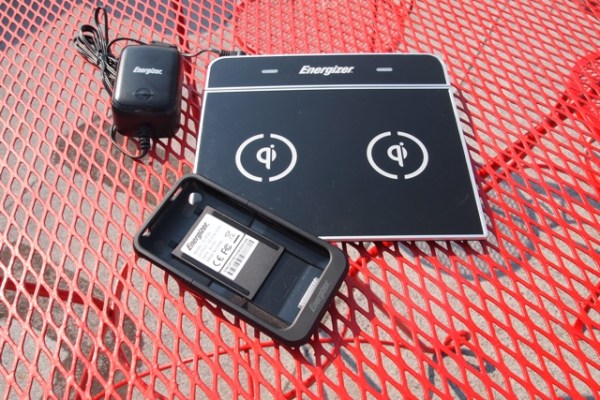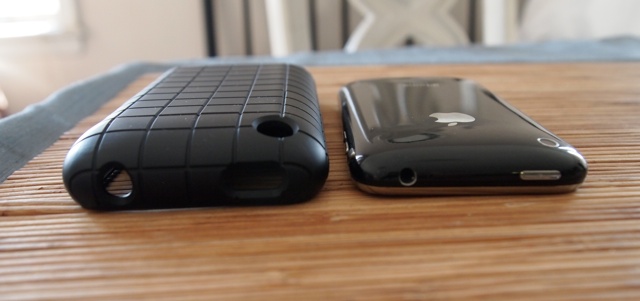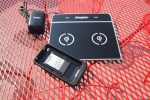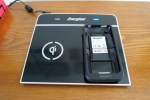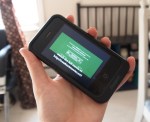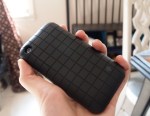Short Version: Energizer’s Inductive Charging pad gets rid of the wires, looks nice, and just makes getting your charge on easier. Unfortunately, the accessories needed to use the charging pad make your phone fat and ugly.
Features:
- Qi charging technology
- Compatible with iPhone 3G/3GS/4 and BlackBerry Curve 8900
- Dual-zone MSRP: $89.00
- Single-zone MSRP: $54.99
Pros:
- Qi: the universal standard for inductive charging (read: your next phone will likely be supported, too)
- NO WIRES!!! (except the one that plugs in the pad)
- USB port for additional charging
Cons
- Takes a bit longer to charge than a wired method
- The cases are fugly (at least my iPhone 3GS case was)
- The price isn’t super attractive, but Qi is, so that’s mostly forgiven
Long Version:
Energizer’s Inductive Charger is a top-notch charging accessory, no doubt. It was a piece of cake to get it unboxed and ready to roll, and it looks mighty nice on my book shelf. As far as design goes, it’s light and pretty thin, and it’s got a nice silver lining to mix it up amidst all the black. Then again, I get this feeling every time I set my phone down on the pad that I’m somehow a part of the future, yet the hardware doesn’t really embrace that. It’s not especially sleek or innovative in design, and I could do without those massive Qi symbols.
The case is its own beast, with its own pros and cons. Its major +1 would be the fact that you can toss your phone down on a pad and it’s automatically charging. But that’s really just a pro for the system as a whole. The cases, at least my iPhone case, added quite a bit of beef to the size of my phone. If I’ve learned anything about technology in my short 23-year life, it’s that “thin and light” is where the money’s at, while “bulky and heavy” is a serious no-no. Past that, the case really doesn’t provide any protection for your phone, despite the fact that it seems thick enough to stop a bullet. If you drop your phone while it’s in the case, you not only run the risk of busting your phone, but you could also mess up the case. And then where would you be?
All three cases — the iPhone 4, iPhone 3G/3GS and BlackBerry Curve 8900 — cost $34.99.
The charging pad features LED lights above both charging areas to let you know that your phone is in fact connecting to the device and receiving a charge. The Dual-Zone charger even has an extra USB port along the backside to give our gadget-packing friends an extra charging option. The Singe-Zone charger, which will launch later this year, does not have the extra USB port. This is also a magnet-free inductive charger, which means that you don’t have to worry about exact placement when you plop down your phone. As long as it’s in the right general vicinity, it’ll charge.
Now to talk about Qi: First of all, it’s pronounced “Chee,” and it is the new universal standard for inductive charging. Anything that requires 5 watts of power or less (phones, iPods, cameras) can work with Qi technology and that will be our primary method for inductive charging going forward. That means you won’t need a new charger when you upgrade to a new phone. All you’ll need is the proper accessory (unless of course your cool new phone features Qi technology already, which it very well may).
As far as performance is concerned, it took me 3 hours, 23 minutes to get my phone charged using Energizer’s Inductive charging pad. With a wired connection, it usually takes me an hour, maybe a little more if it’s completely dead. Obviously, there’s a big difference there. Time is money and nobody has three hours to wait around for a phone to charge. My fear is that because it takes so long, owners of the Energizer charging pad will resort to charging their phone through the night. This is also a serious no-no. Letting your phone stay plugged in after it’s fully charged only kills your battery, and I’m sure no one needs any extra issues with battery life.
Conclusion: In the end, what you win with this device is also what you lose. You get the added convenience of a wire-free charge but the inconvenient three-hour wait to go from dead to a full battery. It really all depends on what you hate more: wires or waiting.
